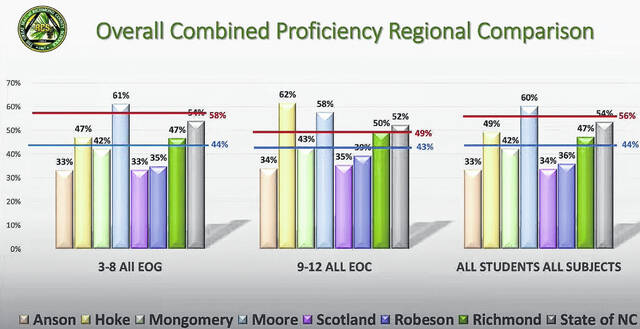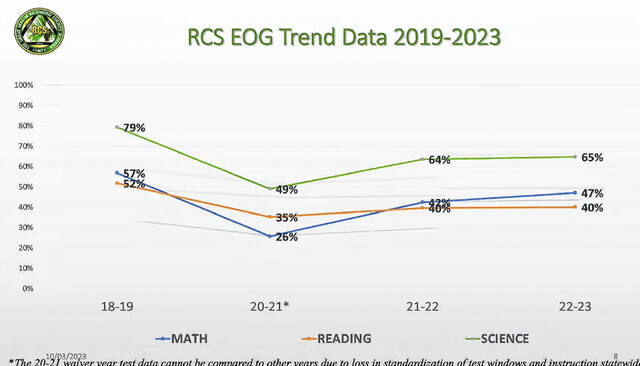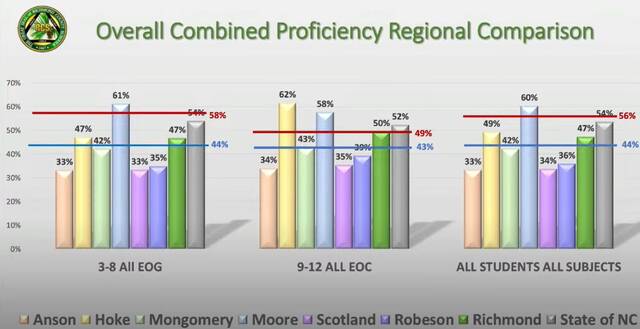
A graph of the overall combined EOG and EOC proficiency compared to last year. Richmond County is the green bar. The blue bar indicates last year’s results, while the red bar indicates pre-COVID results.
Data courtesy of Richmond County Schools
HAMLET —End-of-year testing data from the 2022-23 school year was shared with the Richmond County Board of Education this week.
Richmond County Schools improved three points in 3-8 End-of-Grade testing, seven points in 9-12 End-of-Course testing and three points in all subject and student data from last year’s data.
The EOG results still trail pre-COVID numbers from about 11 points. The EOC results exceed pre-COVID numbers by one point, and trail pre-COVID numbers by 12 points in the third category.
Similar to most rural counties, Richmond County is below the state average in many, but not all, categories.
“Our students are showing gains in overall achievement and closing the learning loss gap, while at the same time, nearing current state averages,” said Jennifer Taylor, Director of Testing and Accountability. “I cannot overstate the importance of the numbers we see represented here. It represents a whole year of dedication of those teachers and students who showed up to school every day and worked hard and the parents who supported them. Because of their efforts, we are seeing gains.”
Taylor said in years of lower attendance, test scores are also lower, according to the data.
“Math is an area of strength with an overall increase of five points across grade levels over last year,” Taylor said. All grades still trail pre-COVID data, although third-graders in 2023 are just about matching pre-COVID numbers.
43% of seventh-graders tested grade-level proficient this year in Richmond County, a small improvement from last year, but only 34% of eight-graders were proficient, a steep decline from the previous year.
“This group of students that transitioned from elementary to middle during the shutdown may have been more affected by the learning loss,” Taylor said.
EOG science data indicate modest gains overall, improving from last year, but still trailing pre-COVID data from about 10 points. 68% of eight-graders are grade-level proficient in Richmond County.
All Biology, English 2, Math 1 and Math 3 exceeded performance in last year. Math 1 and 3 scores have surpassed pre-pandemic numbers, by two and twelve points respectively.
“Our district is moving in the right direction and making strong recovery with the many challenges facing our schools,” Taylor said about the EOC data from the four year window.
Taylor said that Richmond County is relatively consistent across courses, suggesting common practices and strong district support. She commended the county’s Math 1 scores, which rank highest in the region, besting Moore County, and beats the state average by 13 points.
The cohort graduation rate at Richmond Early College exceeded 95%. At RSHS, the graduation rate was 77% in 2023, a decline of five percent from 2021. At Ashley Chapel, the graduation rate was 69%, a figure that is trending upwards from previous years.
According to the Education Value-Added Assessment System, schools that exceeded growth in RCS were Cordova Middle, Hamlet Middle, Mineral Springs Elementary, Monroe Avenue Elementary and the Ninth Grade Academy.
Schools that did not meet expected growth were East Rockingham Elementary, RSHS and Washington Street Elementary.
To summarize, Taylor said that the data is trending in the right direction showing increase in proficiency from last year, the county is closing gaps in state average and the cohort graduation remains relatively consistent.
To improve the graduation rate, Taylor pointed to the presence of a drop-out prevention coordinator at the high school, as well as the addition of a student support advocate. She also added that there is a “laser focus on attendance at all grade levels.”
Board member Cory Satterfield said it would be interesting to see how many students they lost from the school system during the course of the pandemic. To address a question about the graduation rate, Taylor said that RCS is lower than the state average, but matches many other rural communities.
COVID update
Of course, all of that testing data is weakened when students are absent due to illness. Director of Student Services Dr. Wendy Jordan outlined how they are handling COVID-19 in the school system this year.
Dr. Jordan said that during summer school, there were zero reported cases of COVID, and with the beginning of a new school year, COVID cases are popping up.
From the first day of school through Sept. 29, there have been a total of 34 positive COVID cases at the elementary level, 25 at the middle and 36 at the high, primarily concentrated among students. In total, 14 staff members and 81 students have test positive, about 1% of both the staff and student population.
School districts now follow COVID guidance from the Center for Disease Control and Prevention. Hand washing, proper cough and sneezing etiquette and staying home when sick are the biggest ways to prevent the spread of COVID.
Students and staff who are exposed to COVID do not need to stay home unless they begin to develop symptoms. Once symptoms, start to develop, they are encouraged to be tested.
When there is a positive COVID test, the procedure is to isolate for five days, and if symptoms are not being exhibited a return to the classroom is possible. Jordan said that a school nurse should be notified of a positive test result and a return date can be given. While school nurses track the information, they don’t report the information to the health department like they did in previous school years. It’s recommended that students mask if they’ve been exposed to someone who has tested positive, but it’s not required.
Jordan said they still one nurse extender whose salary is paid for via the health department, although that position will end at the end of the year. Jordan added a COVID illness for staff is simply treated like a respiratory illness and staff are not paid for time missed, similar to surrounding school districts.



